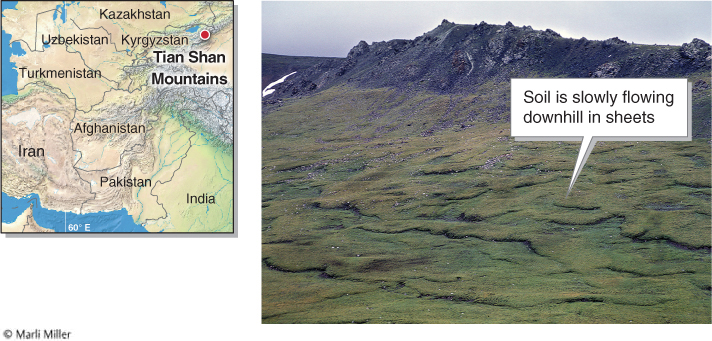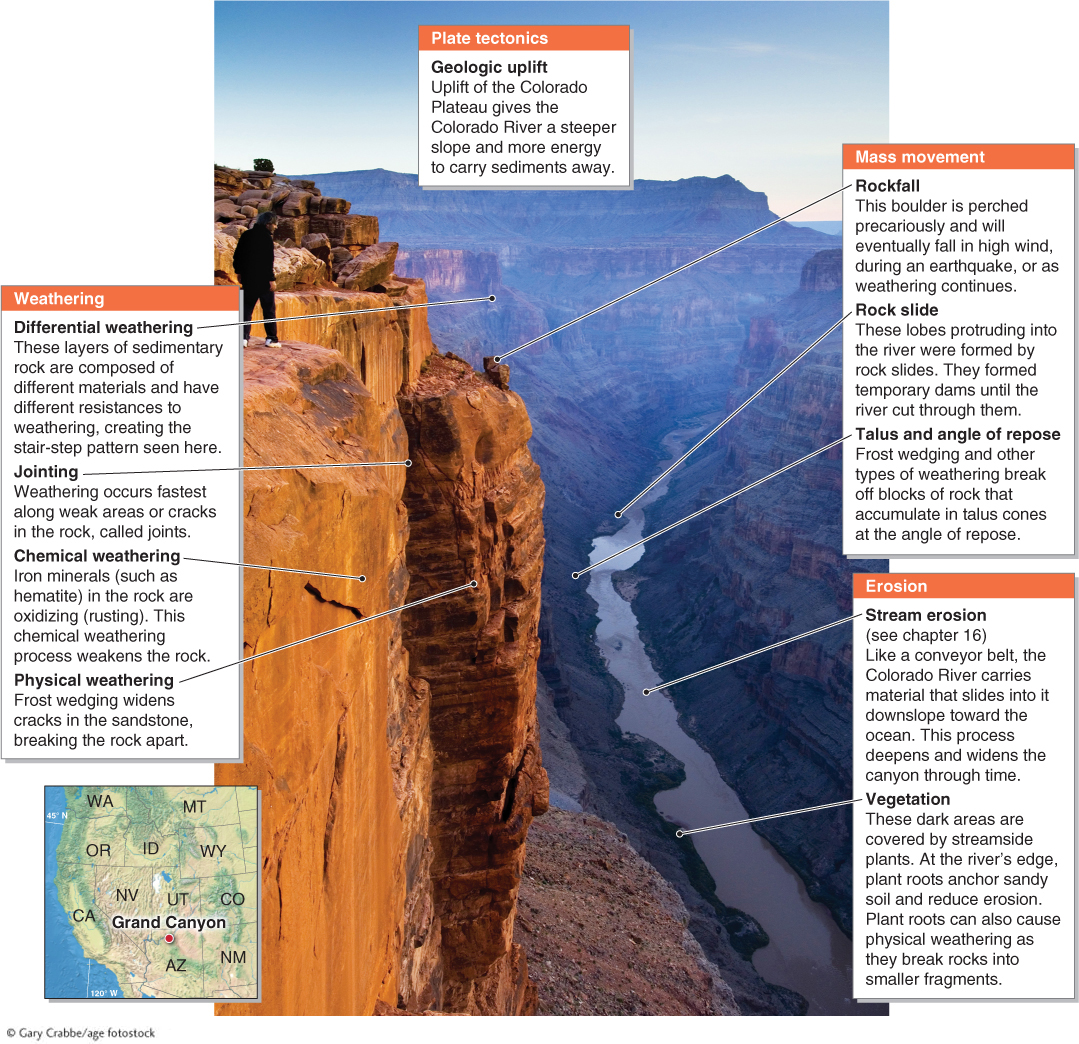15.3 Unstable Ground: Mass Movement
Identify different types of mass movements and describe their behavior and causes.
We have already explored many natural hazards in this book, including tornadoes, hurricanes, volcanoes, and earthquakes. Another significant hazard is posed by soil and rock sliding down a slope by the force of gravity. Landslides and other similar events are collectively called mass movement (or mass wasting) events. Mass movement is the movement of rock, soil, snow, or ice downslope by gravity.
mass movement
(or mass wasting) Downslope movement of rock, soil, snow, or ice caused by gravity.
Why Mass Movement Occurs
A slope is stable when it is unlikely to fail and unstable when it has failed (experienced mass movement) in the past or is likely to do so soon. Several factors, summarized in Table 15.1, create weak layers within rocks, regolith, or snow and potentially create an unstable slope.
|
Geologic faults |
|
Jointing in rocks |
|
Foliation planes in metamorphic rock |
|
Layers of saturated clay or sand |
|
Layers of ice between snow layers |
Conversely, several factors increase slope stability. Friction and electrical charges hold soil particles together. Soil moisture and plant roots also anchor regolith and keep it from moving. Vegetated regolith that is moist, but not saturated, is far more stable than dry and unvegetated regolith. The surface tension of water and the roots of plants both help bind particles together.
A material’s angle of repose (see Section 14.1) is determined by the equilibrium between gravity pulling particles downward and friction holding particles in place. Larger particles have steeper angles of repose than smaller particles. Put another way, the stability of a slope depends on the relationship between resistance force, which keeps the material in place, and downslope force (or gravitational force), which induces the material to slip downhill (Figure 15.20).

Mass movements can be caused by any factor that increases the downslope force or decreases the resistance force. The main factors that can change these forces and result in slope failure are summarized in Table 15.2.
|
FACTOR |
EFFECT ON DOWNSLOPE AND RESISTANCE FORCES |
|---|---|
|
Earthquakes |
Ground shaking can increase downslope force. Ground shaking can also separate particles of regolith and decrease the friction that holds them together. |
|
Rivers and roadcuts |
Steeper slopes are subject to greater downslope force. Rivers often undercut their banks and make them steeper. Roadcuts may make slopes steeper and more likely to fail. |
|
Ground saturation |
As soils become saturated, they become heavier, and the downslope force increases. Saturation moves soil particles farther apart, reducing friction between them. Mass movement commonly follows storms that bring heavy, soaking rains. Broken water pipes on steep slopes can also lead to mass movement. |
|
Weathering |
Increased weathering weakens the integrity and strength of rocks and regolith. |
|
Removal of vegetation |
Removal of vegetation and its anchoring roots weakens the ground and decreases the resistance force. |
Types of Mass Movements
There are many different types of mass movements, and they range in duration from hundreds of years to a few seconds. We will explore mass movement types, starting with the slowest and most gradual and working up to the fastest and most dangerous, in the sequence shown in Table 15.3.
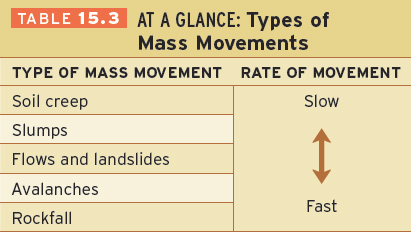
Soil Creep
Soil creep is the imperceptible downslope movement of soil and regolith as their volume changes in seasonal expansion-
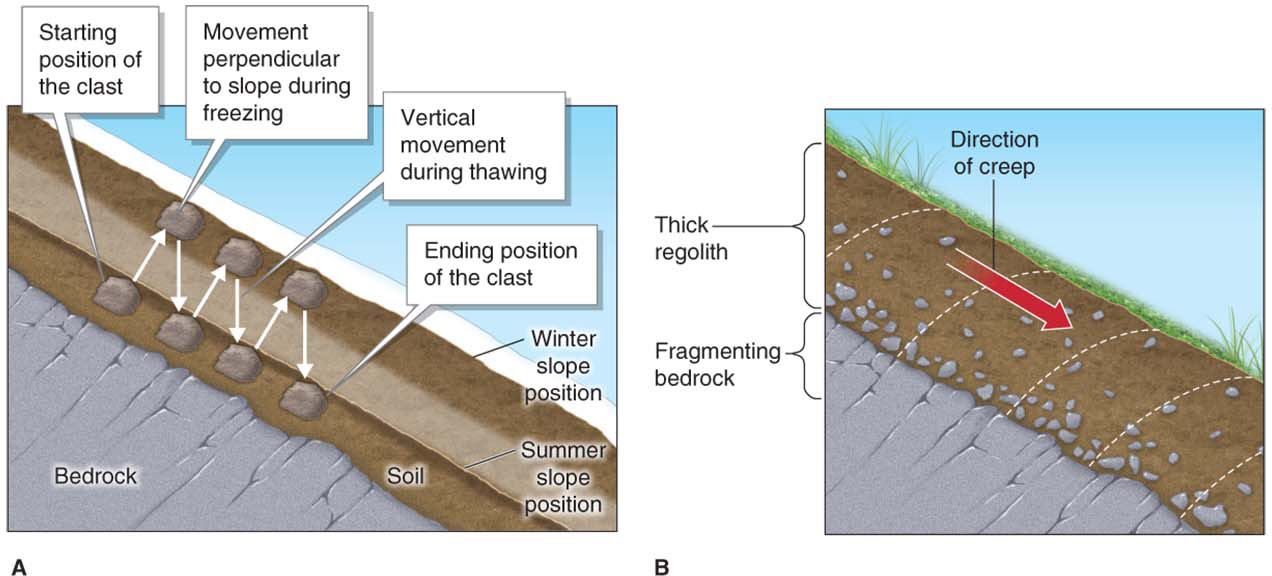
soil creep
The imperceptible downslope movement of soil and regolith as their volume changes in seasonal expansion-
These small movements add up to significant downslope migration of soils after many years. Soil creep is like the tides: It is too slow to be seen in motion, but its effects are easy to see in a landscape (Figure 15.22).
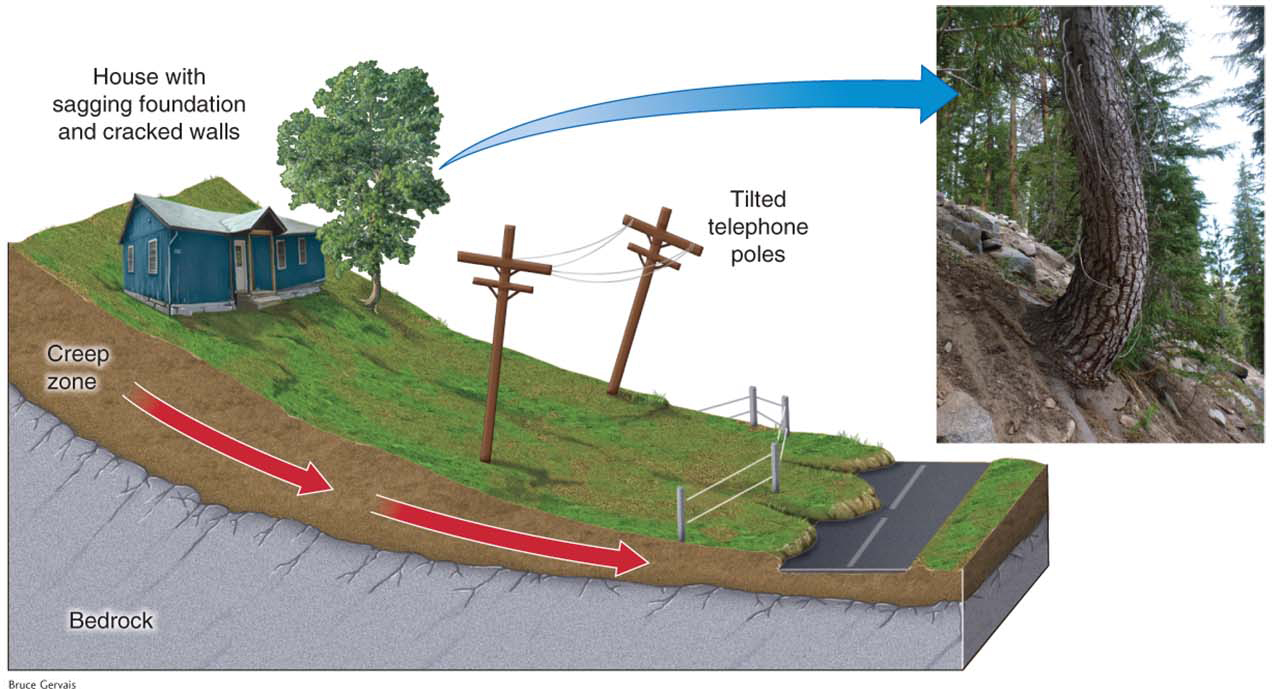
A special type of soil creep, called solifluction, occurs in northern and alpine tundra (see Section 8.4). Solifluction is a type of soil creep in which freeze-
solifluction
A type of soil creep in which freeze-
Another type of imperceptible soil movement is caused by the movements of livestock, particularly cattle, on the slopes of hills. This phenomenon is explored in Picture This.
Slumps
A slump is a type of mass movement in which regolith detaches and slides downslope along a spoon-
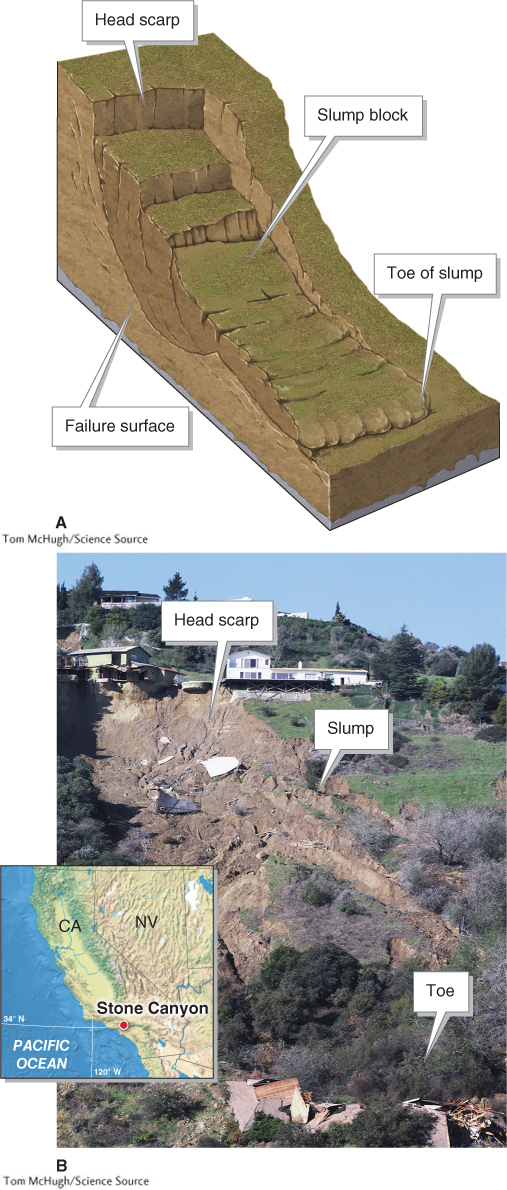
slump
A type of mass movement in which regolith detaches and slides downslope along a spoon-
Flows and Landslides
Flows and landslides are common occurrences in all mountainous regions. Landslide is a general term for the rapid movement of rock or debris down a steep slope. Flows are always mixed with large amounts of water, and overall, they move less quickly than landslides.
landslide
Rapid movement of rock or debris down a steep slope.
There are several different kinds of flows. Their surface areas vary from a few square meters to tens of square kilometers. Their rate of movement depends on the type of flow, the water content of the moving material, and the steepness of the slope. On gentle slopes, they may move at the rate of a slow walk, but on steeper slopes, it may be impossible to outrun them.
Mudflows are fast-
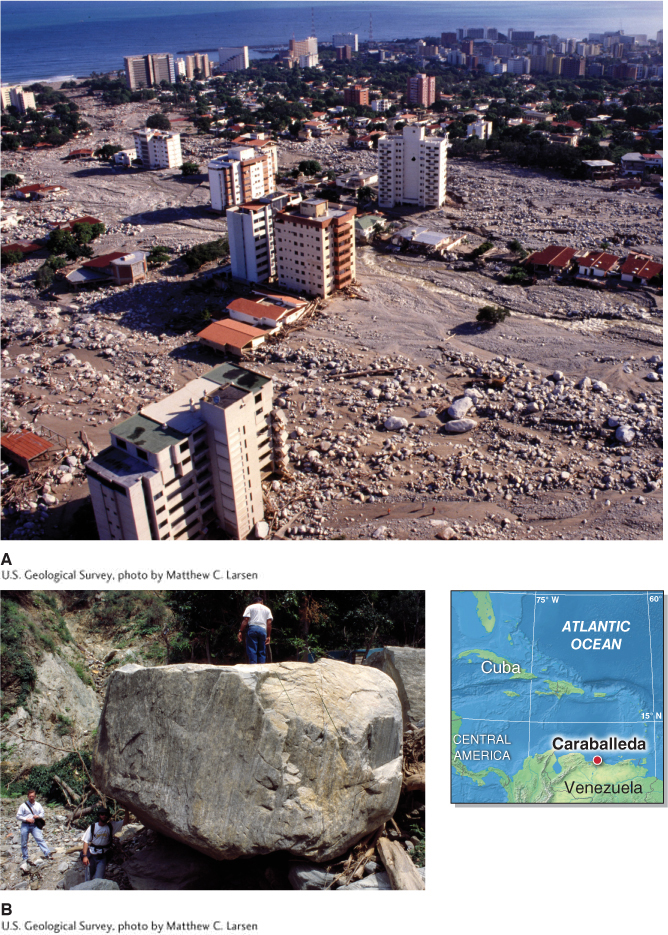
mudflow
A fast-
debris flow
A fast-
Picture This
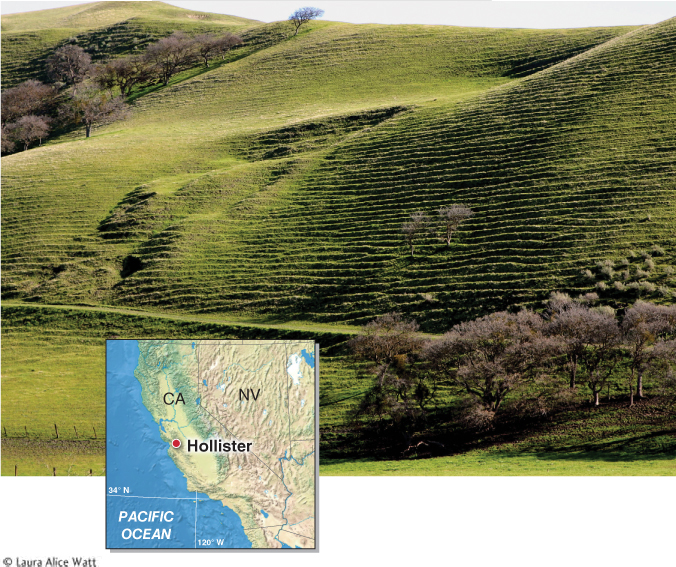
Cattle Terraces
These parallel ridges, called cattle terraces (or livestock terraces), are near Hollister, California. The terraces are trails that cattle have created as they walk along the hillside. There is nothing special about the soils where cattle terracing occurs. The terraces are formed because the slope is too steep for the cattle to walk straight up or down, so they must instead follow a line of equal elevation, or a contour. Cattle terraces are common on slopes of intermediate steepness where cattle are grazed in large numbers. If a slope is too gentle, cattle will not follow the contours, and terraces will not develop. Likewise, if a slope is too steep, cattle will not graze on it for fear of falling. Cattle terraces are a form of mass movement similar to soil creep or solifluction.
Consider This
Question 15.9
Why do cattle follow the contour of the hillside rather than walking straight up or down the hill?
Question 15.10
If you went to a new area and saw what looked like cattle terraces, what evidence would you look for to support the hypothesis that cattle made the terraces?
All landslides occur in mountainous terrain where slopes are steep (but not vertical). They can move at rates of several hundred kilometers per hour and come to rest within minutes after the initial movement begins.
 A rock slide is a landslide that consists predominantly of rocks and broken rock fragments, and a debris slide (or debris avalanche) consists of regolith and other material, such as soil and trees. Heavy rains and earthquakes often trigger the slope failure that gives rise to landslides. At the end of this chapter, the Geographic Perspectives discusses the hazards of landslides and the efforts of scientists to predict slope failure and save lives. Figure 15.26 details the techniques scientists are using to monitor ground movement on unstable slopes.
A rock slide is a landslide that consists predominantly of rocks and broken rock fragments, and a debris slide (or debris avalanche) consists of regolith and other material, such as soil and trees. Heavy rains and earthquakes often trigger the slope failure that gives rise to landslides. At the end of this chapter, the Geographic Perspectives discusses the hazards of landslides and the efforts of scientists to predict slope failure and save lives. Figure 15.26 details the techniques scientists are using to monitor ground movement on unstable slopes.
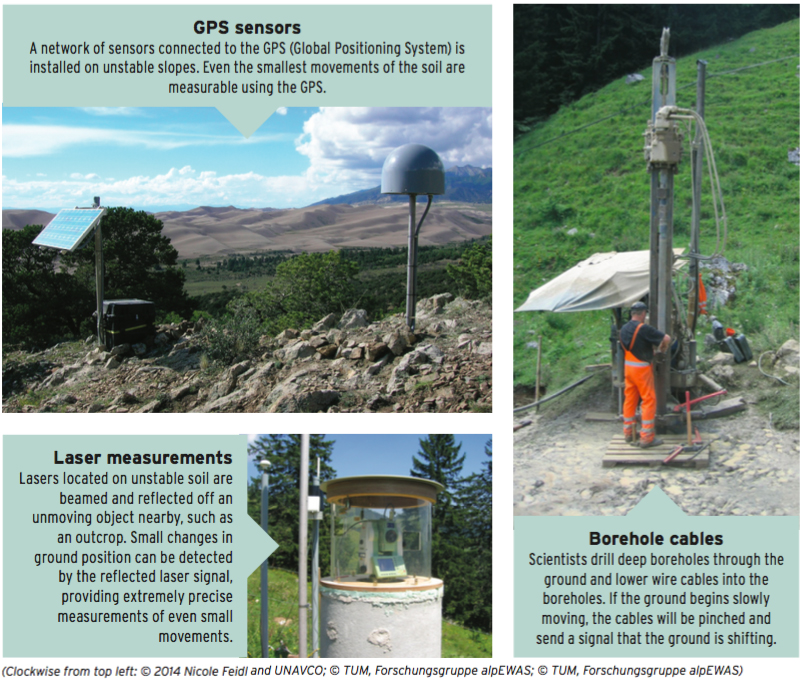
rock slide
A landslide that consists of rocks and broken rock fragments.
debris slide
A landslide that consists of a mixture of rocks, soil, and vegetation.
Question 15.11
Where are the highest sea cliffs in the world?
The north coast of Moloka‘i, in the Hawaiian Islands, has sea cliffs that are the highest in the world.
Landslides also occur on the seafloor where slopes are steep. Much of the coastline of the Hawaiian Islands, for example, is dominated by enormous head scarps formed by undersea debris slides that occurred before the islands were settled by people (Figure 15.27).
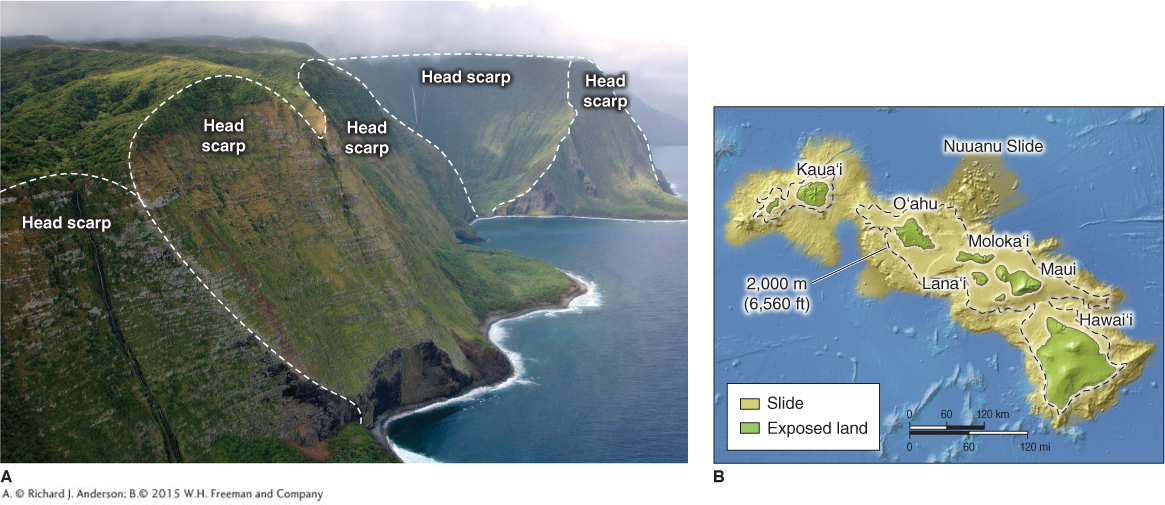
Avalanches
National Geographic photographer and adventurer Jimmy Chin did what few people have ever done: He rode a snow avalanche 300 m (984 ft) down a mountain and survived. While Chin was on a photo shoot in the Grand Tetons of Wyoming, a “large, wet slab” cracked loose around him as he began a downhill ski run. As the churning cloud of snow consumed him, he struggled to stay on top. He knew that when it came to rest, the snow would compact and entomb him like cement and he would suffocate within minutes. He managed to work his way to the surface before the avalanche came to a rest. He was bruised and shaken, but alive.
Broadly defined, an avalanche is a turbulent cloud of rock debris or snow that is mixed with air and races quickly down a steep slope. Snow avalanches are composed mostly of snow. If the avalanche consists of rock, broken trees, and other material, it is called a debris avalanche. Avalanches are mixed with air and are therefore extremely turbulent. They gain such momentum that they are capable of knocking down trees and buildings in their path. Like slumps, they are triggered when a slip at a failure surface releases snow or debris. Snow avalanches often happen in the same area repeatedly, forming avalanche chutes through which snow and debris avalanches regularly move (Figure 15.28).
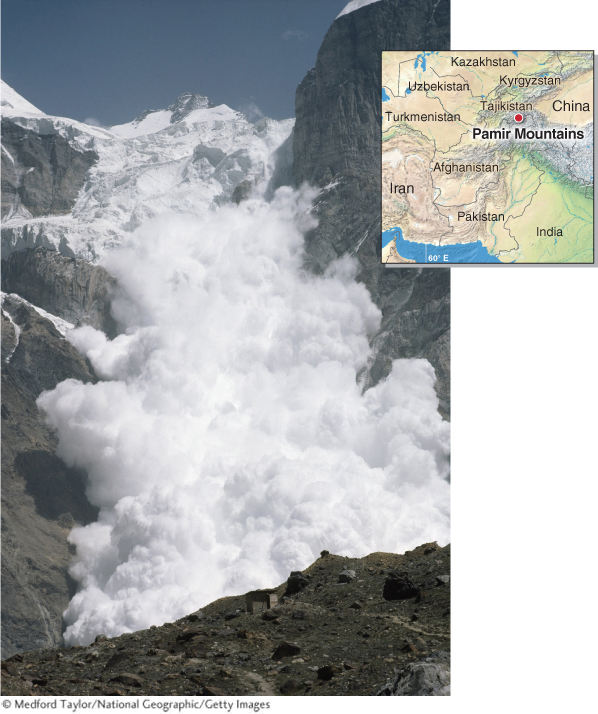
avalanche
A turbulent cloud of rock debris or snow that is mixed with air and races quickly down a steep slope.
Rockfall
Rockfall occurs when rocks tumble off a vertical or nearly vertical cliff face (Figure 15.29). As rocks fall, they are broken apart into smaller fragments and dislodge other rocks as well. Rockfall is particularly common along roadcuts. Near rocky cliffs, the asphalt surface of roads is often pitted by earlier rockfall events.
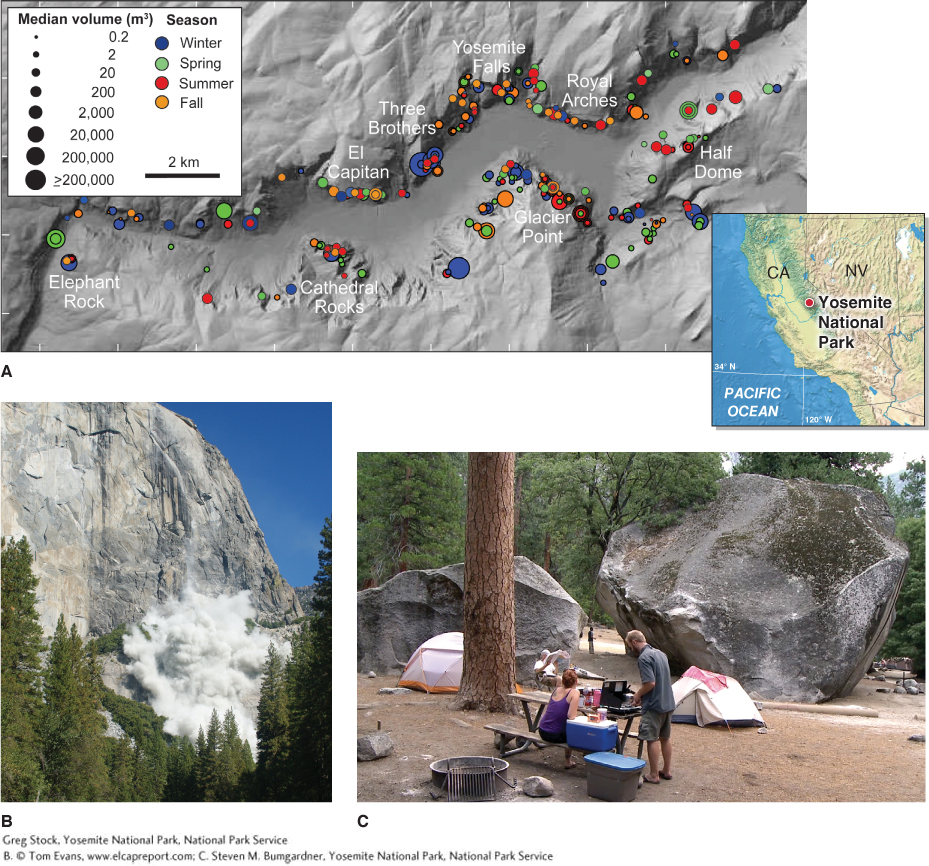
rockfall
A type of mass movement in which rocks tumble off a vertical or nearly vertical cliff face.
Rockfall caused by frost wedging on steep mountain faces often creates piles of rock. The pieces of angular broken rock that accumulate at the base of a steep slope or vertical cliff are called talus (or scree). Repeated rockfall events in the same location can carve notches into the bedrock called rockfall chutes. Talus accumulates at the base of rockfall chutes in cone-
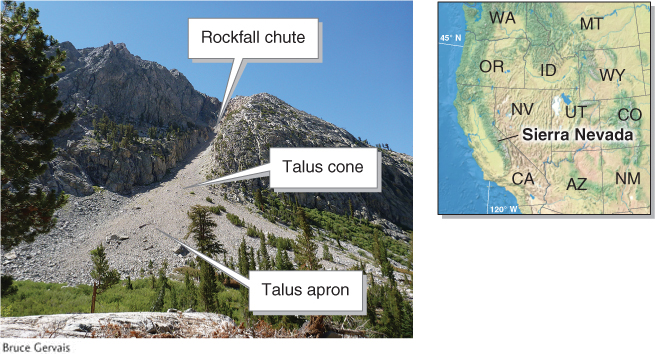
talus
(or scree) Pieces of angular broken rock that accumulate at the base of a steep slope or vertical cliff.
The agents of weathering and mass movement all act simultaneously and continuously to reduce the vertical relief that Earth’s internal geothermal energy has built up. Figure 15.31 reviews these processes in the context of the Grand Canyon.
